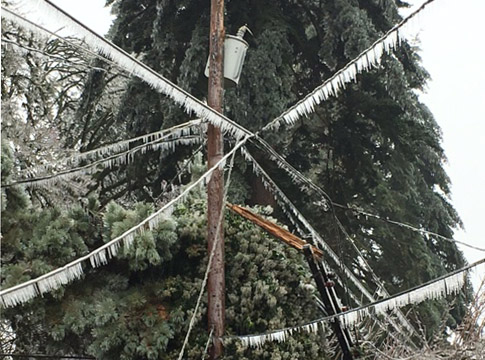Related News
Related News
-
Sustainability Snapshot - Celebrating Energy Efficiency Projects in the Community
Sustainability Snapshops highlight impactful projects completed by EWEB's Customer Solutions department, as a way to celebrate the meaningful work happening behind the scenes.
Find Out More -
EWEB Sets 2026 Budget and Rates, Advances Evaluation of McKenzie Valley Service Territory Realignment
Taken together, the 2026 budget and rate adjustments and the territory-realignment evaluation reflect EWEB’s dedication to responsible financial stewardship, modern, resilient utility infrastructure, and thoughtful planning for the future.
Find Out More -
Let's Talk Turkey. Is your family ready for winter?
We're heading into the holidays, but that also means snow, ice, and not-so-nice weather might be in the forecast. Here are some tips to prepare in advance.
Find Out More -
EWEB Partners with Eugene School District 4J to Celebrate New Kennedy Middle School Emergency Water Station Site
Hundreds of attendees practiced filling up water containers at Saturday's demonstration event.
Find Out More -
Electric Projects underway in North & South Eugene
Underground lines and disaster-resilient power poles are part of EWEB’s infrastructure upgrade near Eugene’s largest natural resource area.
Find Out More -
The Bonneville Power Administration Rate Change and Your EWEB Bill
BPA’s finalized rate increase is smaller than projected, and EWEB’s pass-through adjustment effective October 1, 2025 will now be 2.7% for residential customers—down from the anticipated 4%.
Find Out More -
Join the Pledge to Prepare
When you think about getting ready for an emergency, you probably have questions. You aren't alone. Preparing for emergencies can be overwhelming, which is why EWEB has put together a 12-month program to help you and your family get two weeks ready.
Find Out More -
You can’t predict the next disaster, but you can prepare
The earthquake lasted less than a minute. But now the power’s out. The tap runs dry. Cell service is spotty. Would you be ready?
Find Out More -
EWEB prepares for wildfire season with risk mitigation measures
EWEB is building a more resilient electric system to weather various types of disasters, from wildfire to winter storms.
Find Out More -
EWEB Pilots New Line Safety Program for 4th graders.
This year, EWEB is ramping up power line safety for children, specifically 4th graders.
Find Out More -
Hayden Bridge celebrates 75 years of service as EWEB looks forward to a new era of water resiliency
EWEB Water Treatment Supervisor, Toby Dixon, looks back at how the Hayden Bridge Water Filtration Plant has changed over the years and explains what EWEB is doing to secure a more resilient water future.
Find Out More -
Watch the Recording: Financial Preparedness for Disasters
How will you financially recover after a disaster? This seminar gives key insights into preparing your finances ahead of time.
Find Out More -
Greenpower subscribers vote to award Greenpower Grant to SquareOne Villages
The Greenpower Grant, funded solely by voluntary customer subscriptions, supports local sustainability projects.
Find Out More -
EWEB reaffirms commitment to resilience with Wildfire Mitigation Plan approval
The utility is testing new equipment, leveraging technology, and incorporating third-party expertise to bolster electric system resiliency to a range of threats, including wildfire.
Find Out More -
Energy conservation could offset large portion of growth in power demand
Preliminary results of an EWEB study indicate that cutting back demand can contribute to maintaining a reliable, affordable energy supply.
Find Out More - Show More
FEMA provides $3.5 million to EWEB to help with ice storm recovery costs
May 30, 2017

The Federal Emergency Management Agency awarded $3.5 million to EWEB in late May to help offset the financial costs of the devastating ice storm that struck Eugene on Dec. 15, 2016.
The ice storm was among the most severe faced by EWEB and our customers over the 106-year history of the utility. The trees and wires brought down by the ice, along with damage to poles, transformers and other infrastructure, affected approximately 22,000 customers.
We spent approximately $4.7 million restoring service to customers and making repairs to our electric transmission and distribution system from Dec. 15 through Dec. 24. The FEMA grant of $3.5 million covers about 75 percent of our costs.
We maintain a $2 million operating reserve to cover unanticipated costs. We covered the destruction caused by the December ice storm with working cash that had accumulated throughout the year.
The $3.5 million from FEMA will go back into the working cash fund. We will absorb the $1.2 million not covered by the FEMA grant without raising electricity prices - customers have not, and will not, incur any additional costs resulting from the storm and the recovery efforts.
We did not increase residential electricity prices in 2017. In addition to the $1.5 million EWEB budgets for low-income assistance each year, we added another $100,000 following the ice storm to help customers cover bills due to the prolonged cold snap.
"The December ice storm was devastating for EWEB and our customers in many ways. From a financial perspective, this was the largest restoration effort in EWEB's 106-year history," said Susan Fahey, EWEB's chief financial officer. "The FEMA grant will help our customer-owners, who already endured extensive and prolonged power outages, avoid further financial impacts."
There were more than 1,600 tree incidents affecting EWEB infrastructure during the ice storm and its aftermath. City-wide, there were more than 3,200 trees removed or pruned due to storm damage. The ice also caused significant damage to streets and private property, including homes and vehicles As the ice storm hit, our emergency managers began calling in outside electric repair crews to help with restoration.
In addition to the five EWEB crews, 24 crews from other utilities and private contractors helped restore service. EWEB and the outside crews repaired 135 linear miles of wire, 185 poles or cross arms and replaced 44 transformers.
Learn more about what to do if your power goes out.

